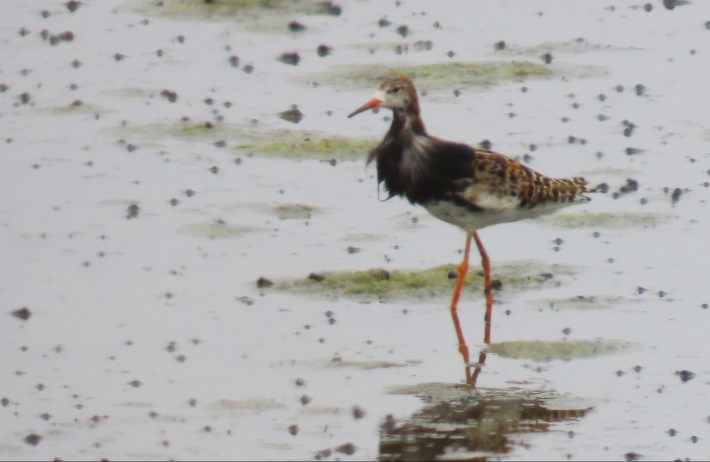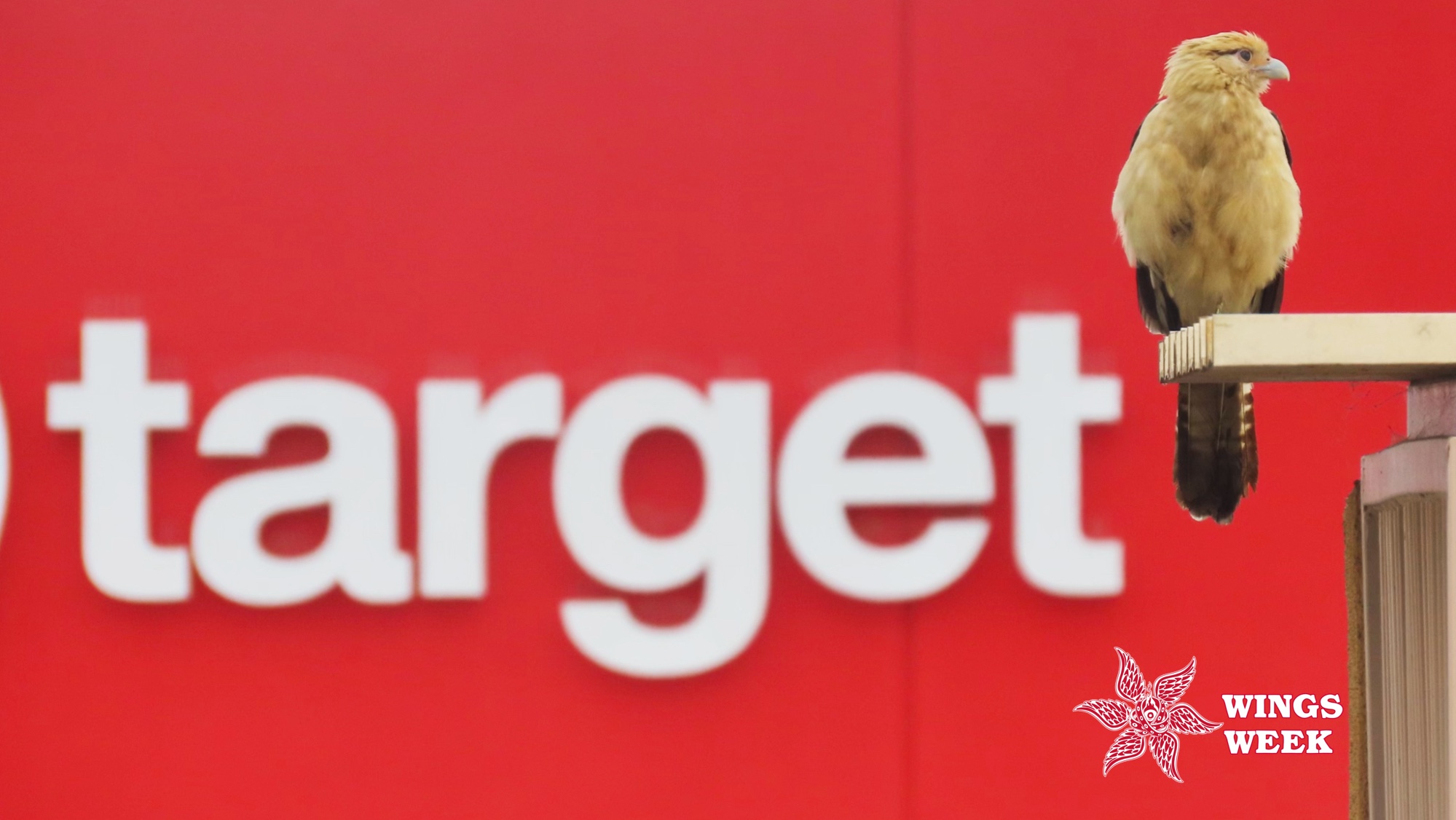LOS ANGELES — We were in a hotel on the coast, celebrating our anniversary with a weekend away, when I got a text from a friend: “FYI Ruff at Ballona Wetlands.” As delicately as I could, I told my wife there was an incredibly rare bird—a vagrant, far outside its normal range—just 15 minutes away. We had lunch plans. She didn’t even sigh, just looked at me kindly and said, “Go.”
A ruff is a shorebird with some cachet: Males in breeding plumage can look outlandish, with a highly variable collar of feathers that places them somewhere on the spectrum between Vincent D’Onofrio in The Cell and Gary Oldman as Dracula. (Fun fact: A small subset of males called faeders have the same coloration as the drabber females; they use this disguise to hide among females and avoid the competition of displaying males. According to the Cornell Lab of Ornithology, “The faeder’s strategy involves waiting until a female signals to a displaying independent [male] that she’s ready to mate. At this critical time, the faeder quickly ducks in and mates before the independent has a chance.”) More importantly, as I ditched lunch in Venice Beach that day, ruffs breed in the northern reaches of Europe and Asia, not the Ballona Wetlands—the only remaining coastal marsh in the Los Angeles basin, and therefore a key birding hotspot for the West Coast’s most populous city.
Ordinarily, because I live on the eastern side of Los Angeles County, Ballona Creek may as well be on another planet. But on that particular morning it was just two miles from our hotel. Within an hour of getting the text, I was in a group of birders delightedly watching a male ruff forage around a salt pan. The black collar of feathers swished and changed the shape of the bird from moment to moment. It gave the familiar movements of a sandpiper a theatrical air; it was an otherwise ordinary shorebird wearing a feather boa to forage for coastal invertebrates. Top-tier anniversary. I love my wife.

Vagrant birds, when spotted, become little mobile hubs of the birding community. Thanks to the digital record-keeping of eBird, birders have separate lists of their sightings for the country, county, and state they inhabit—plus their “life list” of worldwide birds. A birder in Irvine who’s been to Norway may well have a ruff on her life list, but it’s unlikely she has a California ruff to nudge her state stats up, so she’d head to Ballona as soon as the ruff got shared with rare bird alert groups on social media.
For me, though, it’s less about padding stats than it is an admission that my time is running out. I’m 45 years old; the odds say I have enough decades left to get good at gull identification (the “learning tax code” of birding), but maybe not. I have soft but realistic plans to visit Costa Rica, a birder’s paradise, but constant or extensive global travel doesn’t look likely for the life I have left. I’m comfortable—not happy, but at peace—with the knowledge that I will die with a long list of birds I wish I could have seen. So when a piece of that distant world flies to me, I go see it.
That’s how I ended up driving 45 minutes to a Popeyes along the border of Lomita and Torrance, where a yellow-headed caracara had set up shop and was surrounded by as many telephoto lenses as courtside at the NBA Finals. Caracaras are falcons that behave like vultures, and the only species native to the United States is the crested caracara, which, let’s be honest here, looks like it’s wearing a cheap toupée. Many naturalists frown upon anthropomorphizing birds, but still: big divorced dad energy.
By contrast, the yellow-headed caracara, a primarily South American species that rarely ventures north of Costa Rica, cut a distinct figure on top of the Popeyes dumpster: earthy yellow body under chocolate wings, a dark line streaking back from its eye, and a raspy cry in league with the famed red-tailed hawk scream that gets dubbed onto eagles in movies and television. The gossip around this new arrival was rich and unsourced. Because the species hasn’t shown a proclivity for vagrancy, some believed that the bird had arrived by stowing away on a container ship and eating scraps along the way. (Having once spent two months on a Navy ship, I can relate to the urge to head directly to Popeyes upon landfall.) However it arrived, it was worth the 90 minutes of driving for less than 10 minutes of looking at a piece of Brazil, Colombia, Panama, Aruba. Imagine: Something from the Amazon rainforest in front of a damn Target in Torrance. How marvelous!
My birding hobby has recentered around chasing vagrants and rarities since I moved to California from New England a year ago. (It is probably worth noting my own migration patterns: I’ve lived in 10 states and have moved roughly two dozen times in my life. Of course I’m drawn to wanderers.) In Connecticut, I was able to bird at least five days a week most of the year, an hour or so in the window between taking my kids to school and starting work. It was a habit of comfort, logging familiar species in familiar places. Now, because my workday starts earlier (East Coast bias is real), I’m lucky to go birding beyond my backyard once a week.
With fewer reps available, I take bigger swings. This past winter, two vagrants native to Central and South America shared the same space on the east side of Griffith Park: a hepatic tanager, named for the adult male’s rusty liver-red feathers, and a thick-billed kingbird, a large flycatcher with the same brown-gray-yellow-white feathering as a half-dozen other species in the family Tyrannidae. As I wandered the same hillside trail five times over the course of November and December, I wondered if I could distinguish it from similar species. How thick can the bill really be? The answer, when it finally appeared in a tree directly above me days before the New Year: Oh. Yeah, I see now.
A few weeks later, I learned of a white wagtail frequenting an upper section of the L.A. River. With an estimated global population of 860 million, the white wagtail is one of the more common and widespread birds in Europe and Asia, but it “enters North America only as a scarce and local summer resident of western Alaska,” according to Audubon. I found it in the runoff from a drainpipe creating an algae-ridden puddle in the L.A. River’s concrete aqueduct, where it stuck out with its black bib, white mask, and penciled-in black eyeline. Its tail bobbed more than wagged, but as bird names go, it’s hardly the most problematic.

I worry about the vagrants, and about all birds outside their natural range: a glorious Mandarin duck in a pond next to an L.A. sheriff station that eBird deemed an escapee; the famous Flaco while he lived in Central Park; the handful of northern red bishops—spectacularly bright red-orange songbirds of Africa—that breed in the San Fernando Valley. I want them to have fulfilling lives, to live their expected lifespan, to mate successfully, to somehow find a way back home—but ideally after lingering long enough on an exposed branch at eye level so I can snap some photos. It’s not possible, or at least not reasonable, but you don’t pick up a hobby of looking at dwindling species during a global climate crisis without a spark of hope: that a poisoned owl could find joy in a final year of freedom after more than a decade of captivity, or that a lone wagtail, one of almost a billion, could spend a winter on the wrong continent but migrate north to Alaska come spring, meet a handful of friends, and head back home with them.
The thing I am not saying—a thing that I don’t particularly like talking about—is humanity’s role in the vagrancy and displacement of birds. Vagrants are blown across oceans by increasingly violent storms bred by our dependence on fossil fuels. The destruction of their habitats send them looking for new territory. Their capture brings them to places they don’t belong; the logistics of modern humanity offer them rides beyond horizons their instincts would never take them.
I would prefer to be excused from this reality, to be a totally passive observer, to let geomagnetic space storms be the sole cause of vagrancy. But I can’t. It’s here, out my back door, by the dozens in the towering eucalyptus in my yard. I live in Pasadena, the epicenter of a massive wild parrot population descended from generations of escapees. Urban legend tells of a fire at a pet store in the 1950s or ‘60s that led to a mass release, but the more likely, though less exciting, story is that scores or hundreds of individuals originally sold as pets were released when their owners discovered their raucous screeching and long lifespans.
The red-crowned parrot is by far the most numerous of the Pasadena species, with the most ear-splitting screeches. In their native Mexico, the parrots are gravely threatened by deforestation and the pet trade. I find it one of the more darkly comic twists of the Anthropocene that a native species has been nearly eliminated by poachers and illegal pet traders, who shipped the birds to southern California, where people discovered they were terrible pets and released them, which then thrived in the vast collection of exotic and non-native fruit trees—to the point that there are now more red-crowned parrots in southern California than in Mexico. The layers of human interference that led to this accidental ark of preservation feeds the little flame of hope inside me when I see a bird far from its home: Maybe it can make a new one here.






